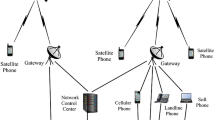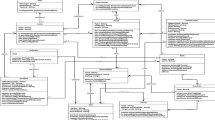Abstract
The development of new technologies in wireless domain provides better service to the users. The demand in wireless network services increases every day, and this leads to spectrum scarcity. Cognitive radio network is a solution for ideal spectrum sensing process. As the user and service increase, also the difficulties and security threats increase. The nature of a cognitive radio network provides better service with security, and this nature becomes vulnerable to the security threats. Resolving such vulnerabilities based on the analysis of CR network basic layers provides a secure network for better communication. This proposed research model is defined for obtaining secure CR network model using Neyman–Pearson criterion and an adaptive neuro-fuzzy inference system for detecting the attacks in the network. Experimental results highlight that proposed model is better in detection efficiency than artificial neural network-based detection models.










Similar content being viewed by others
References
Ahmadfard A, Jamshidi A, Keshavarz-Haddad A (2017) Probabilistic spectrum sensing data falsification attack in cognitive radio networks. Sig Process 137:1–9
Bhunia S, Sengupta S, Vázquez-Abad F (2015) Performance analysis of CR-honeynet to prevent jamming attack through stochastic modelling. Pervasive Mob Comput 21:133–149
Bouabdellah M, Kaabouch N, El Bouanani F, Ben-Azza H (2018) Network layer attacks and countermeasures in cognitive radio networks: a survey. J Inf Secur Appl 38:40–49
Chander D, Kumar R (2018) QoS enabled cross-layer multicast routing over mobile ad hoc networks. Procedia Comput Sci 125:215–227
Chuku EE, Kouvatsos DD (2018) Impact of scalability on the performance of secured cognitive radio networks. Electron Notes Theor Comput Sci 340:123–135
Das D, Das S (2018) An intelligent resource management scheme for SDF-based cooperative spectrum sensing in the presence of primary user emulation attack. Comput Electr Eng 69:555–571
Fang H, Xu L, Li J, Choo KKR (2017) An adaptive trust-Stackelberg game model for security and energy efficiency in dynamic cognitive radio networks. Comput Commun 105:124–132
Feng J, Guangyue L, Wang H, Wang X (2016) Supporting secure spectrum sensing data transmission against SSDH attack in cognitive radio ad hoc networks. J Netw Comput Appl 72:140–149
Han C, Niu Y, Pang T, Xia Z (2018) Intelligent anti-jamming communication based on the modified q-learning. Procedia Comput Sci 131:1023–1031
Hlavacek D, Chang JM (2014) A layered approach to cognitive radio network security: a survey. Comput Netw 75:414–436
Hodgetts HM, Vachon F, Chamberland C, Tremblay S (2017) See no evil: cognitive challenges of security surveillance and monitoring. J Appl Res Mem Cogn 6(3):230–243
Jahandoust G, Ghassemi F (2017) An adaptive sinkhole aware algorithm in wireless sensor networks. Ad Hoc Netw 59:24–34
Jinhui X, Yang T, Feiyue Y, Leina P, Yao H (2018) Intrusion detection system for hybrid DoS attacks using energy trust in wireless sensor networks. Procedia Comput Sci 131:1188–1195
Karunambiga K, Sundarambal M (2015) LU-MAC: licensed and unlicensed MAC protocol for cognitive WiFi network with jamming-resistant. Procedia Comput Sci 47:424–433
Kour H, Jha RK, Jain S (2018) A comprehensive survey on spectrum sharing: architecture, energy efficiency and security issues. J Netw Comput Appl 103:29–57
Li Q, Ding X (2018) Minimizing secrecy outage probability for primary users in cognitive radio networks. AEU: Int J Electron Commun 83:353–358
Ling MH, Yau KLA, Qadir J, Poh GS, Ni Q (2015) Application of reinforcement learning for security enhancement in cognitive radio networks. Appl Soft Comput 37:809–829
Manesh MR, Kaabouch N (2018) Security threats and countermeasures of MAC layer in cognitive radio networks. Ad Hoc Netw 70:85–102
Mneimneh S, Bhunia S, Vázquez-Abad F, Sengupta S (2017) A game-theoretic and stochastic survivability mechanism against induced attacks in cognitive radio networks. Pervasive Mob Comput 40:577–592
Parvin S, Hussain FK, Hussain OK, Han S, Chang E (2012) Cognitive radio network security: a survey. J Netw Comput Appl 35(6):1691–1708
Rashid B, Rehmani MH, Ahmad A (2016) Broadcasting strategies for cognitive radio networks: taxonomy, issues, and open challenges. Comput Electr Eng 52:349–361
Sharifi AA, Sharifi M, Niya MJM (2016) Secure cooperative spectrum sensing under primary user emulation attack in cognitive radio networks: attack-aware threshold selection approach. AEU: Int J Electron Commun 70(1):95–104
Shrivastava S, Rajesh A, Bora PK (2018) Defence against primary user emulation attacks from the secondary user throughput perspective. AEU: Int J Electron Commun 84:131–143
Slimeni F, Scheers B, Chtourou Z, Le Nir V, Attia R (2015) Cognitive radio jamming mitigation using markov decision process and reinforcement learning. Procedia Comput Sci 73:199–208
Soto J, Nogueira M (2017) A framework for resilient and secure spectrum sensing on cognitive radio networks. Comput Netw 115:130–138
Author information
Authors and Affiliations
Corresponding author
Ethics declarations
Conflict of interest
All authors declare that there is no conflict of interest.
Ethical approval
No humans/animals involved in this research work. We have used our own data.
Additional information
Communicated by Sahul Smys.
Publisher's Note
Springer Nature remains neutral with regard to jurisdictional claims in published maps and institutional affiliations.
Rights and permissions
About this article
Cite this article
Neelaveni, R., Sridevi, B. A novel Neyman–Pearson criterion-based adaptive neuro-fuzzy inference system (NPC-ANFIS) model for security threats detection in cognitive radio networks. Soft Comput 23, 8389–8397 (2019). https://doi.org/10.1007/s00500-019-04068-2
Published:
Issue Date:
DOI: https://doi.org/10.1007/s00500-019-04068-2




